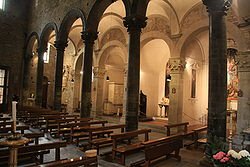- Santi Apostoli, Florence
-
The Church of Saint Apostoli is a church in Florence, Italy. It was built in the 11th century, and, though remodelled in the 15th and 16th centuries, is one of the few in the city to have maintained its High Middle Ages features. It faces the Piazza del Limbo ("Limbo Square), so-called for it anciently housed a cemetery for children who died before having been baptized.
A slab on the façade attributes the foundation to Charlemagne and his paladin Roland, in the year 800, but scholars assign it to the 11th century. A small bell tower was added by Baccio d'Agnolo in the 16th century.
The simple façade, in Romanesque style, has a portal attributed to Benedetto da Rovezzano.
Interior
The plan, with a nave and two aisles with a semicircular apse, still shows Palaeo-Christian influences. It has green marble columns from Prato with capitals stripped from ancient Roman remains (the Corinthian ones probably coming from the baths existing in the area). The richly decorated wooden ceiling was added in 1333. Noteweorthy is the pavement, with a mosaic from the original edifice which was later restored with the contributions of outstanding Florentine families (Acciaioli, Altoviti and others). the apse area has maintained the Romanesque appearance, with undecorated stones visible. The side chapels are from the 16th century.
In the church are conserved some stone splinters from the Holy Sepulchre which are used as a flint to light the fire-works during the "Scoppio del Carro" feast on Easter Sunday, in front of the Baptistery. On the left of the apse are a polychrome terracotta tabernacle by Giovanni della Robbia, and the Tomb of Oddo Altoviti (who financed most of the reconstructions) by Benedetto da Rovezzano. the tomb of Bindo Altoviti has a bust by Bartolomeo Ammannati (1570).
Sources
- __ (2007). Guida d'Italia, Firenze e provincia. Milan: Touring Club Italiano.
Coordinates: 43°46′10″N 11°15′08″E / 43.769312°N 11.252339°E
Categories:- Churches in Florence
- Romanesque architecture in Tuscany
- 11th-century church buildings
Wikimedia Foundation. 2010.



